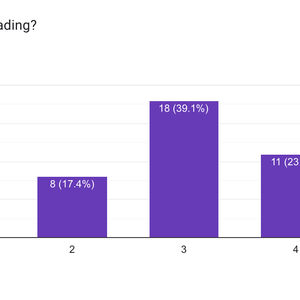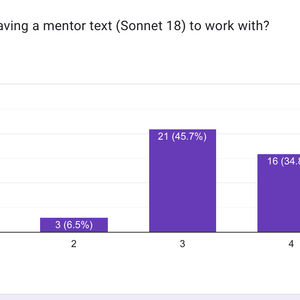Lesson Study Cycle Two
As a lesson group, we wanted to identify how we could use student critical reading skills to help improve student writing skills. Specifically, we wanted to identify the ways in which reading skills can used to further increase writing skills, and if there were ways or techniques to allow us to focus on certain skills that we wanted students to learn. This is a vast question to address within one lesson study, so, while that was the guiding question, we narrowed down the focus to how we could best utilize mentor texts to help increase student writing capabilities. To achieve this, the lesson asked for 9th grade students from HTHMA to write sonnets in honor of Valentine’s Day. For our research, we focused on observing how students used and reference Shakespeare’s Sonnet 18 while writing their own sonnets to see how much they were able to pull and utilize what they read to replicate their own versions.
Teaching Partners:
Felicia Acosta - 9th Grade Humanities
Savannah Kennedy - 6th Grade Humanities
Derek Buitron- Middle School Humanities
Part One: Planning
Goals
Equity Goal: How do we best utilize students’ critical reading skills to further improve their writing skills? Narrowing down, how can we use mentor texts as an avenue for improving student writing skills?
Content Goal: By the end of the lesson, students will know how to construct a sonnet based on understanding sonnet format, style, and, rhyme scheme through reading and instruction about a mentor text.
Research Base
Throughout our lesson study planning phase, we did research on: metacognitive skills involved with reading and writing; the overlap of metacognitive skills used in both reading and writing; the state of research within the field of reading/writing acquisition; and developmental relationships for both reading and writing skills in students.
In regard to our problem of practice, the research allowed us to ascertain what allows students to acquire writing skills from reading, and—to a lesser extent—reading skills from writing. We learned that the generally held assumption that teaching reading to teach writing is accurate,as well as that it is also fallacious to assume that writing can both be taught solely through this method; there must also be education that focus on writing as well. The reason for this is that even though both skills utilize the same types of metacognitive skills, the way that those skills are activated is different based on the activity. To put it in the loose words of one of the articles “same road; different directions.”
Our initial findings based off research, then, allow us to determine that going the route of mentor texts was wise and could lead to positive results as long as there was still focus on writing practices outside of mentor text work.
Read more in my R.A.R., R.R.R., Annotated Bibliography, and Literature Synthesis.
Focal Students
Focal Student #1
-
Enjoyed learning about circuits because her brother is into technology
-
active member of soccer and understands boundaries and how others can affect others
-
Surprised me that she enjoys writing
Focal Student #2
-
Family encouraged him to utilize the resources/opportunities they did not have
-
Has learned to push himself
Lesson Flow
-
Review sonnet structure, format, and rhyme scheme (from lesson day before)
-
Have students fill out graphic organizer during the above process
-
Give students 5 minutes to brainstorm ideas for their own sonnet
-
ask them to write the first stanza of the sonnet
-
Have teacher look it over and give advise during the process (nudging them to look at the mentor text)
-
Repeat process for the last 3 stanzas
PDSA Data

Lesson Slides
Check out the lesson slides

Part Two: How it Went, Student Data, and Student Work
Student Work
Student Data
Student Survey Data about their reception to reading, writing, and using mentor texts

Reflection
Overall, the lesson went…alright(?). The hesitancy is due to a few different factors: the first is that the lesson took place during a short day, which tends to make students unruly; the second is that one of the classes was disrupted by a speaker that took up half the time of the lesson; the third is that, due to the nature of different classes progressing at different speeds, the second class (the one interrupted by the speaker), was behind by a fair bit compared to the morning class. All of these factors made it harder to keep the class on track and get them consistently focused on the material and lesson.
One lesson hiccup that occurred independent of the above is that there wasn’t enough scaffolding to the lesson. The first class, when given the information and task, stalled out on producing sonnets if they didn’t immediately grok the assignment. The ones who did get what was going on were already fairly adept at writing, which, while great, doesn’t necessarily serve to help evident how mentor texts are useful.(In other words, those who struggle already still struggled; those who didn’t, didn’t). What this showed us was that the mentor text, to be more useful, needed to be integrated further into the lesson design and be used in some modeling so that the students could more easily recognize what it was to be used for. We did adapt this for the second class. Instead of front-loading difficult concepts like rhyme scheme, format, correct number of syllables, etc., we asked students to write a free-verse stanza and then introduced the ideas a bit at a time to make them slowly adapt their writing to fit a proper sonnet. Despite how behind the second class was both lesson and time-wise, they had an easier time writing due to this change.
When looking at the data for how impactful the mentor texts were for students, the results were surprising. Doing an initial check during the lessons, we accounted for most students not looking at or having the mentor text around during writing. When looking at the survey, though, most students favorably viewed both the mentor text as an activity and having it around when write their own sonnets. This leads me to the conclusion that the activity wasn’t for naught; in fact, it evidences that what could have made the lesson even better was incorporating an activity that showed students how better to utilize having a mentor text (such as modeling, class practice/writing session/etc.). While this isn’t an immediate result for our problem of practice, it does suggest that we are on the right track and that, if anything, students like having an example for writing. That is something actionable for our classes in the immediate future.



















